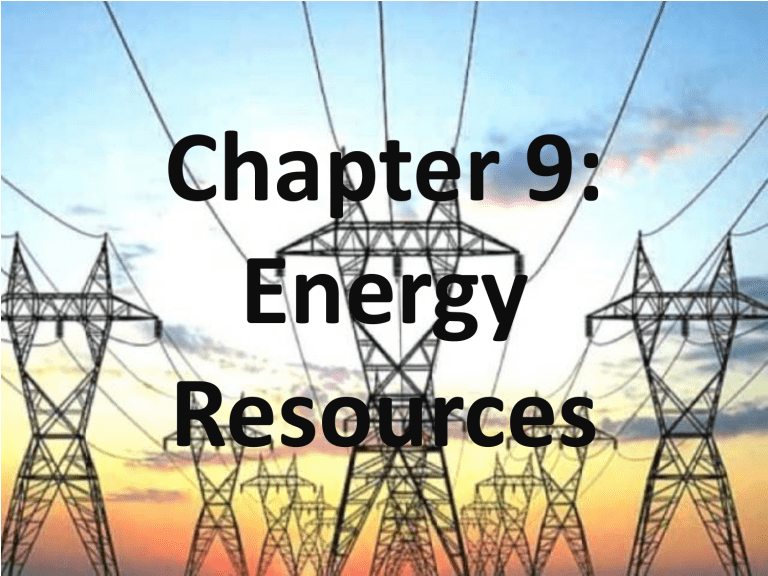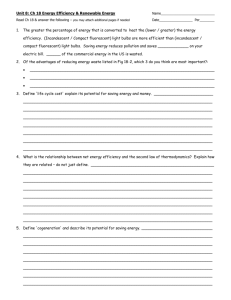Chapter 9: Energy Resources

Chapter 9:
Energy
Resources
Energy Conservation is the practice of using less energy.
•
• Examples: http://study.com/academy/lesson/energy-conservation-and-energy-efficiency-examples-and-differences.html
Renewable Sources of Energy resources that are always there, never run out, and renew themselves easily
Nonrenewable Sources of Energy resources that can be used up and cannot be reproduced
Coal- Advantage
• Easy to transport (move from place to place), burns easily, and cheap
Coal- Disadvantages
Pollutes the air, adds to greenhouse effect due to excessive CO2,
Nonrenewable
Coal- Miscellaneous
Solid fossil fuel made from the remains of dead swamp plants; factories use coal
Oil- Advantage
Produces large amounts of energy, one of the most abundant, easy to transport
Oil- Disadvantages
Pollutes the air, water, and ground! adds to greenhouse effect due to excessive CO2, Nonrenewable
Oil- Miscellaneous
U.S. uses about 1/3 of ALL oil produced in the world, but we only have 3% of Earth’s oil supply in our country: gas for cars comes from refined oil
Solar- Advantages
Pollution free, low maintenance cost, noise free, rebates from the government, renewable
Solar- Disadvantages
Requires sunshine (doesn’t work @ night!) Expensive solar panels
Solar- Miscellaneous
Heats up the inside of cars in parking lots – this is called passive heating: provides electricity
Wind- Advantages
• Renewable
• No pollution
• Cheap once built
• Energy can be stored
• Large amounts of energy produced
Wind- Disadvantages
• Requires strong and steady winds
• Uses noisy generators
• Can kill birds
• Cast shadows on the land
Wind- Miscellaneous
Fastest-growing energy source in the
WORLD; electricity
Hydroelectric- Advantages
Renewable, No pollution, controls the risks of floods, provides water areas that could otherwise be without.
Hydroelectric- Advantages
Renewable, No pollution, controls the risks of floods, provides water areas that could otherwise be without.
Hydroelectric- disadvantages
Dams cause harm to the natural environments, requires HUGE flowing water source. Stop the natural flow of water!
Hydroelectric- Miscellaneous
Most widely-used renewable resource: electricity for homes/buildings
Geothermal- Advantages
Renewable, No pollution, enormous amounts of stored energy! simple and safe
{Watch Youtube: Geothermal Thermal Heating (1:17) animated} https://www.youtube.com/watch?v=lWOa5E2cDHY
Geothermal- Disadvantages
Limited availability
(it’s not easy to get to)
Deep drilling is
EXPENSIVE!
Geothermal- Miscellaneous
In Iceland, most homes are heated with geothermal energy.
{Watch Youtube: Geothermal Energy in Iceland (6:42)} https://www.youtube.com/watch?v=XRAQrDduaU0
Nuclear- Advantages
Produces huge amounts of energy! Brings jobs to a country, cause little pollution
Plant Vogtle, located in Waynesboro, Ga., contains the first new nuclear units in the
US in 30 years.
Nuclear- Disadvantages
Nonrenewable, Produces radioactive wastes (toxic when something goes wrong!)
Plant Vogtle, located in Waynesboro, Ga., contains the first new nuclear units in the
US in 30 years.
Nuclear- Miscellaneous reactor meltdowns can cause environmental harm & dangers
Plant Vogtle, located in Waynesboro, Ga., contains the first new nuclear units in the
US in 30 years.
Biomass- Advantages
Renewable, carbon neutral
Can be made into other fuels
Biomass- Disadvantages
Produces methane gas when it decomposes (this gas traps heat in earth’s atmosphere)
Biomass- Miscellaneous
Can be made from wood, sugar cane, corn, and other crops & garbage ; fuels cars
Hydrogen- Advantages
Renewable
Burn cleanly
No pollution
Hydrogen- Disadvantages
Takes more energy to burn the hydrogen than it will produce when its burned; inefficient
Hydrogen- Miscellaneous
Possible new method to possibly fuel cars


